Financial Planning Plans: strategic, operating,

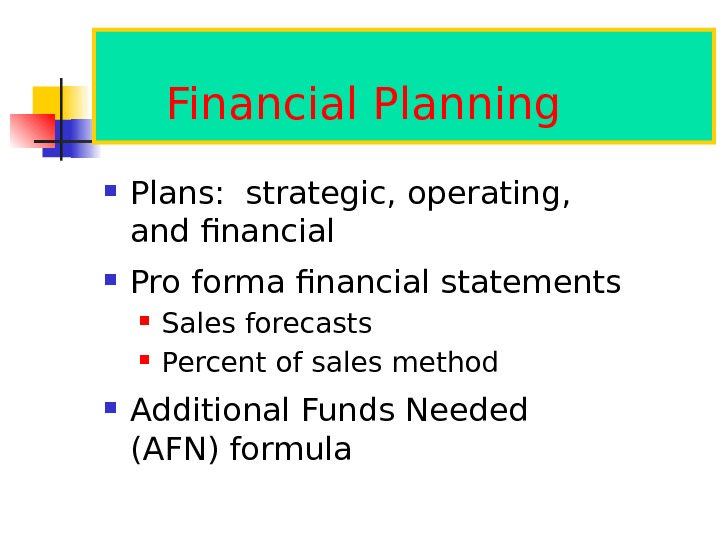
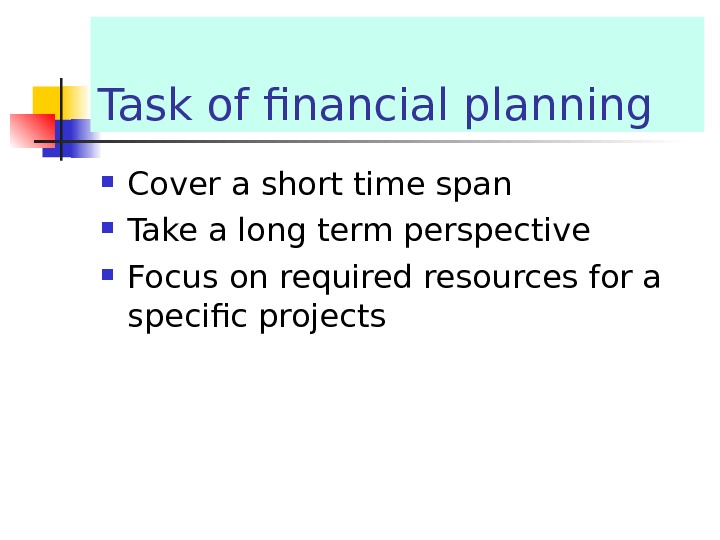
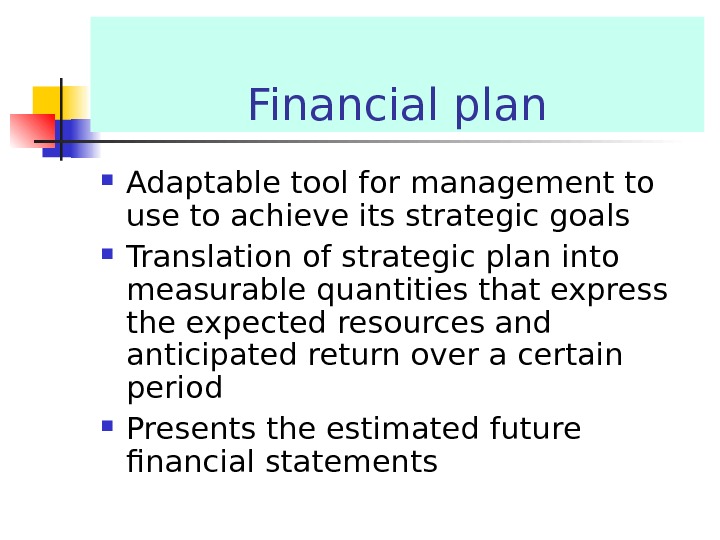
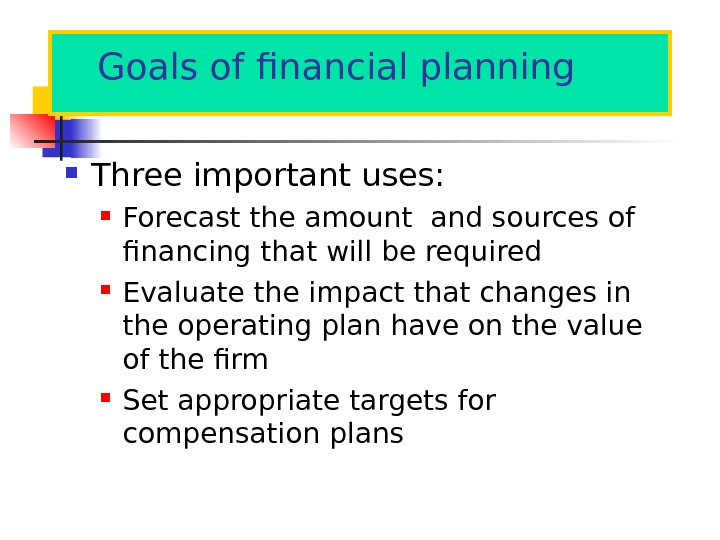
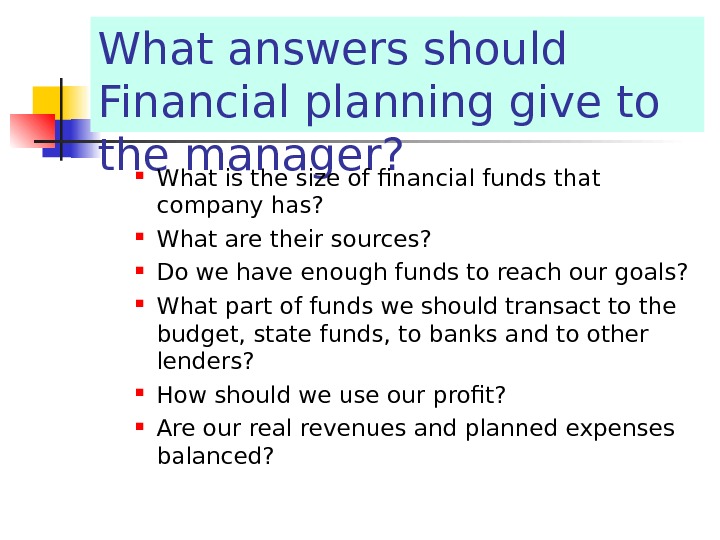
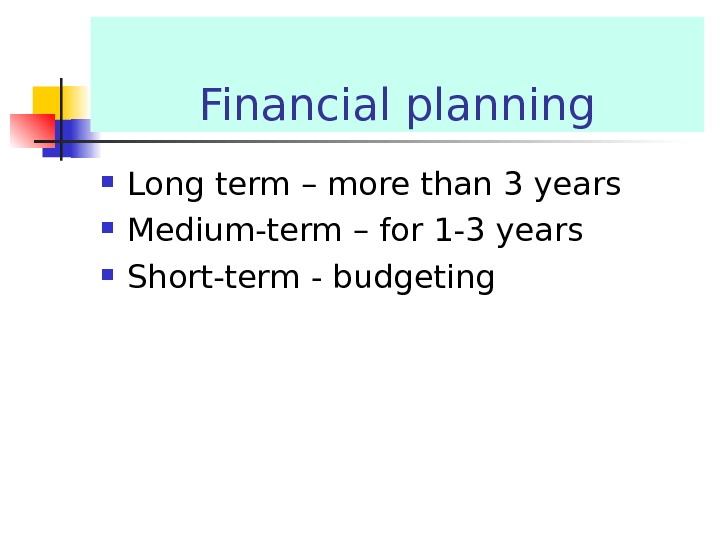
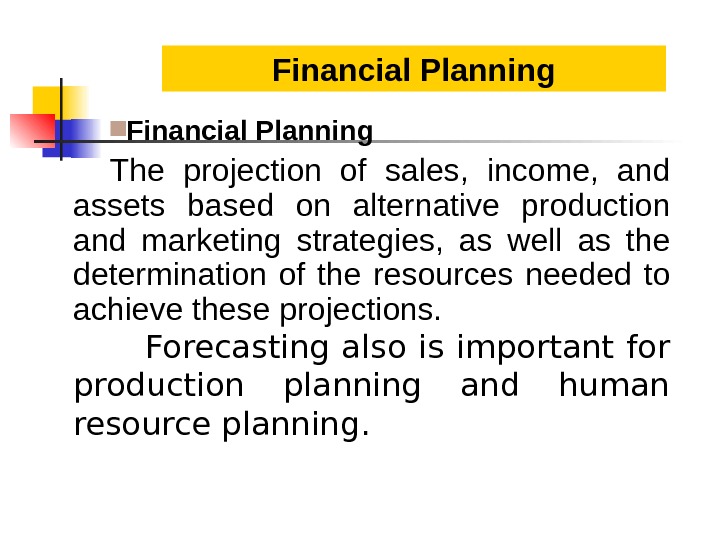
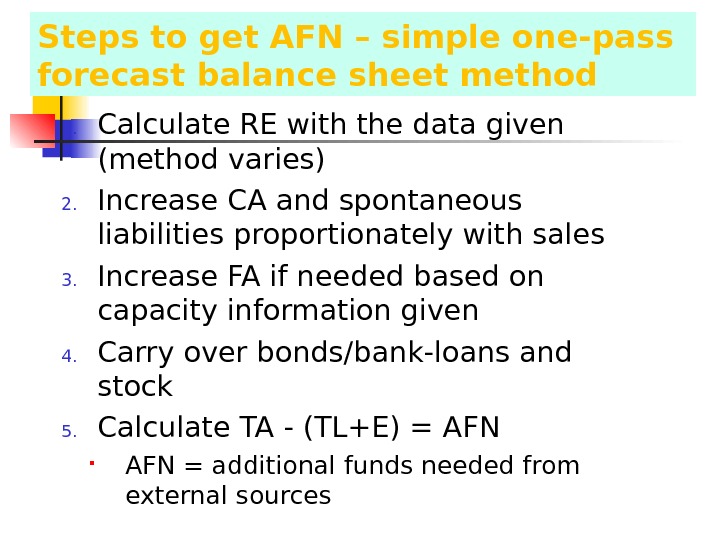
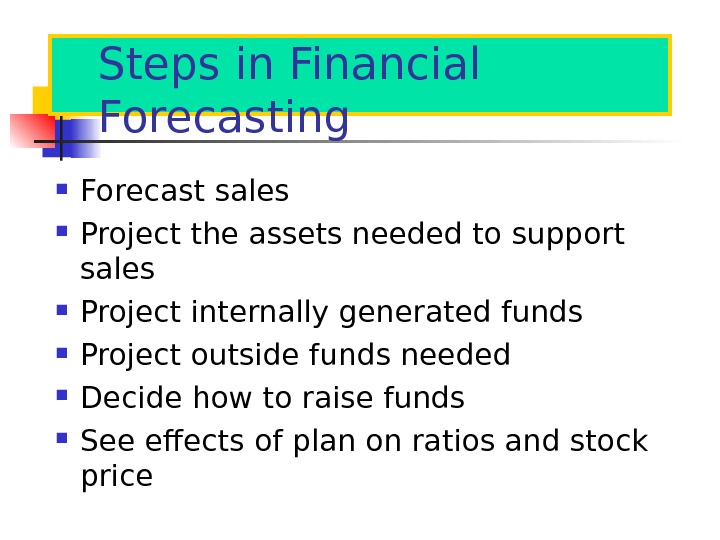
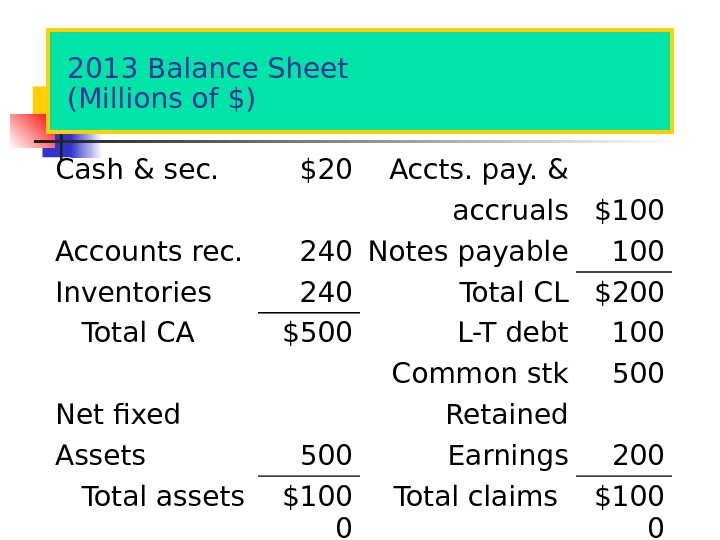
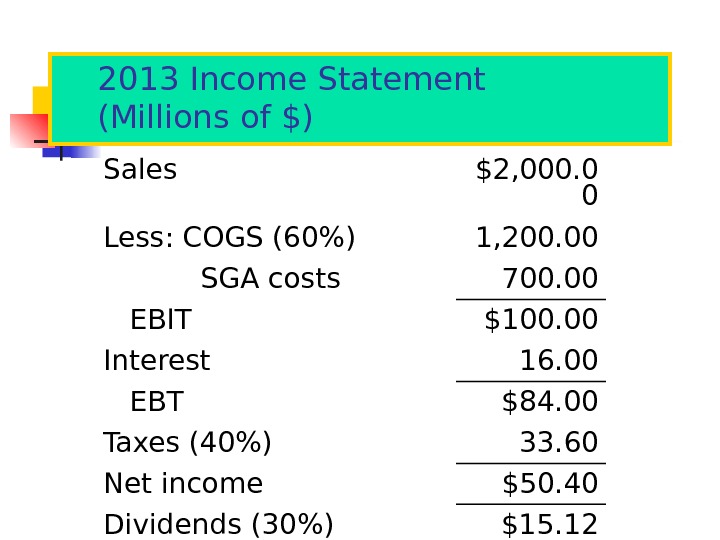
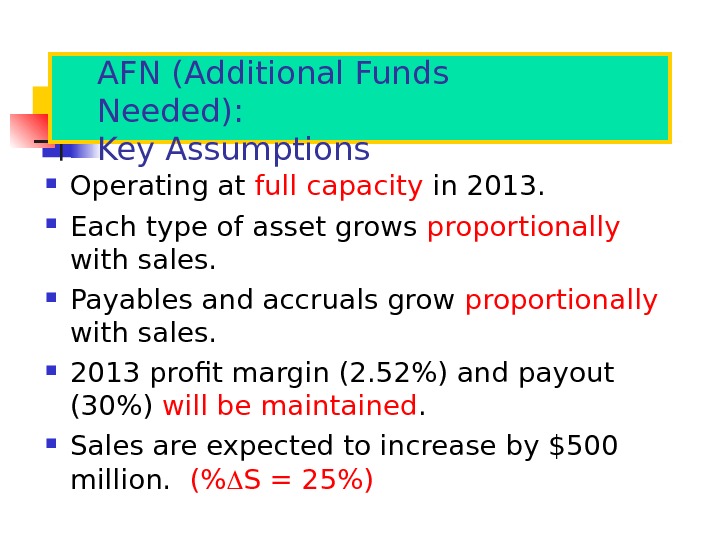
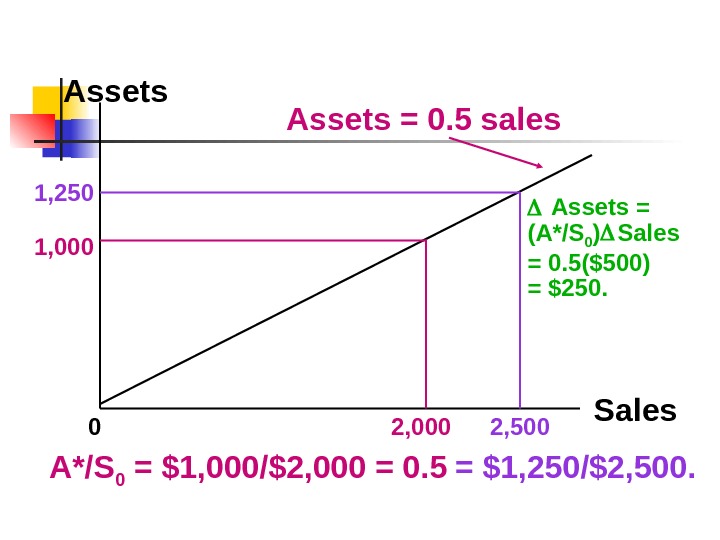

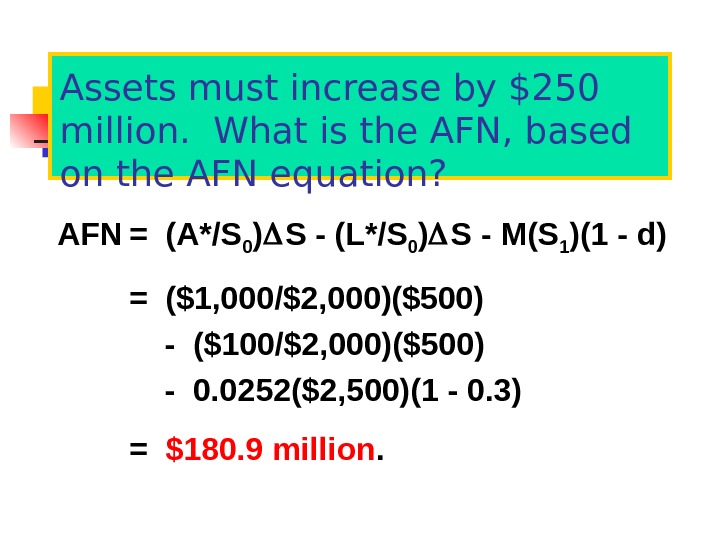
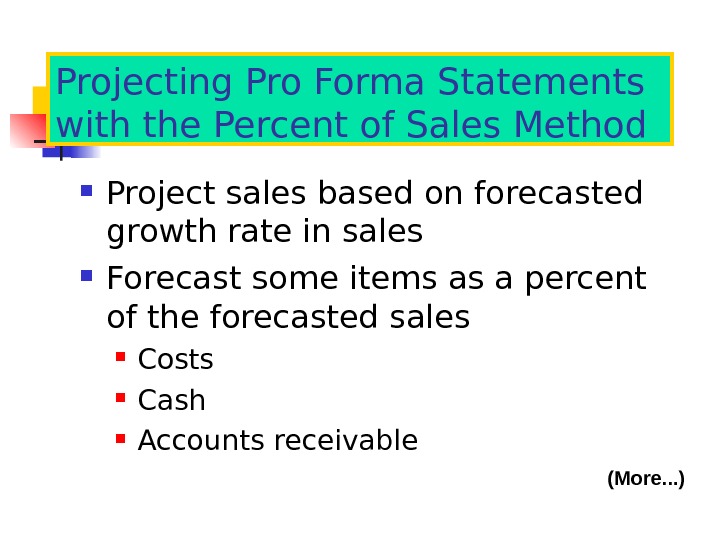
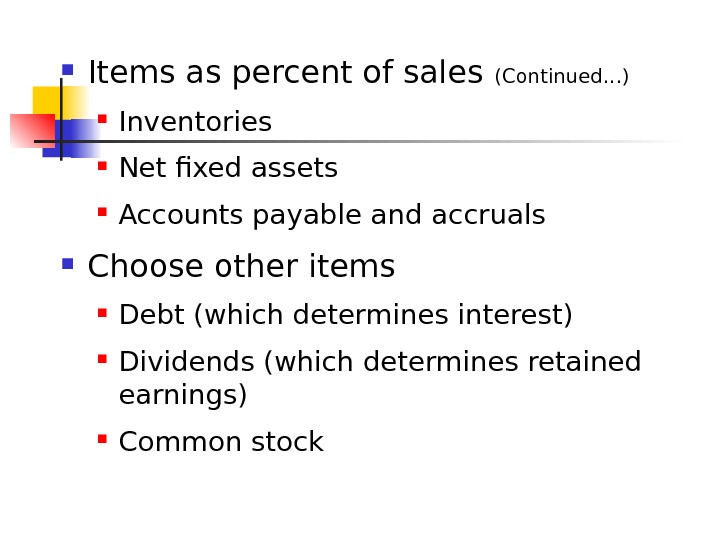
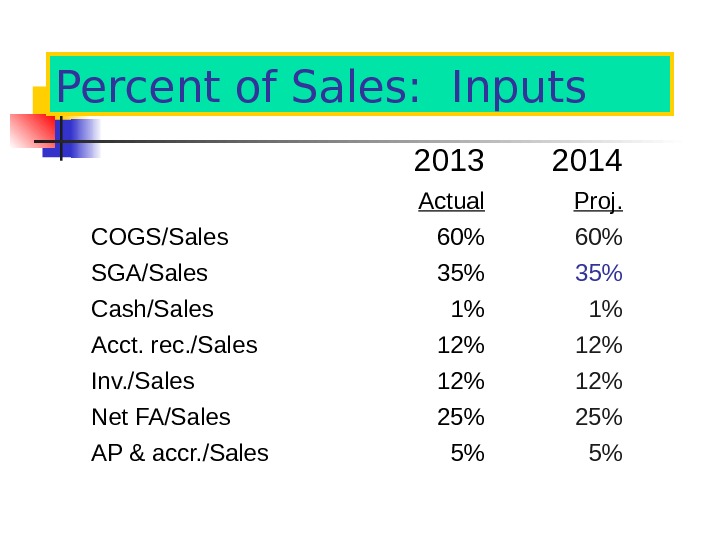
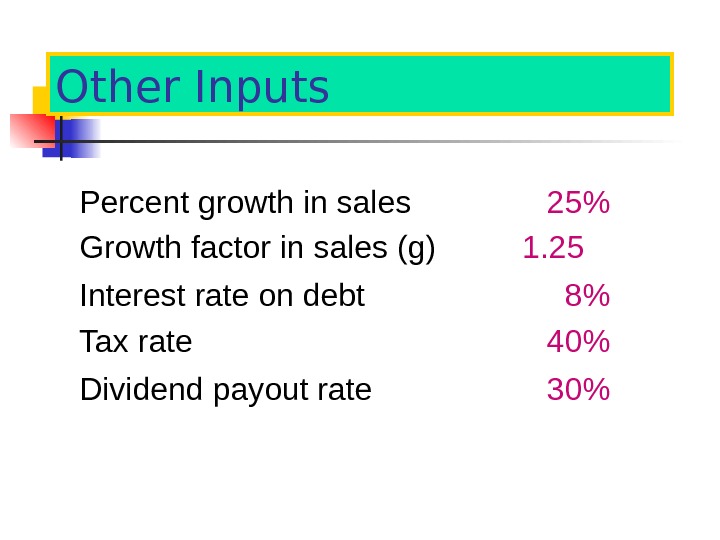
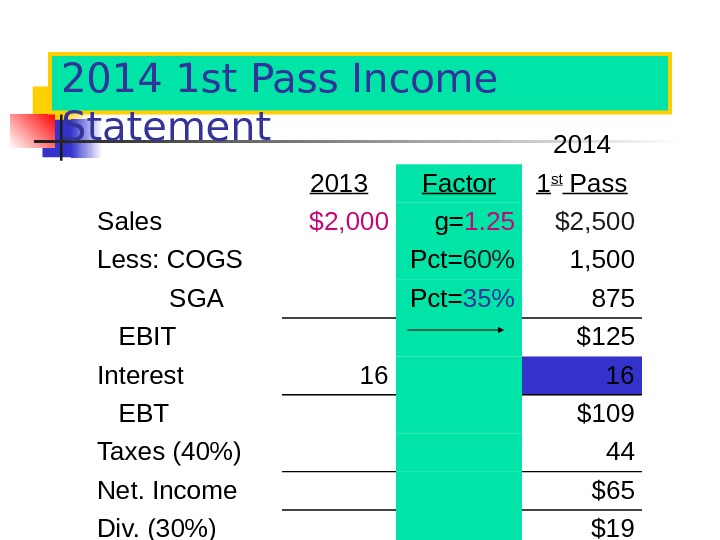
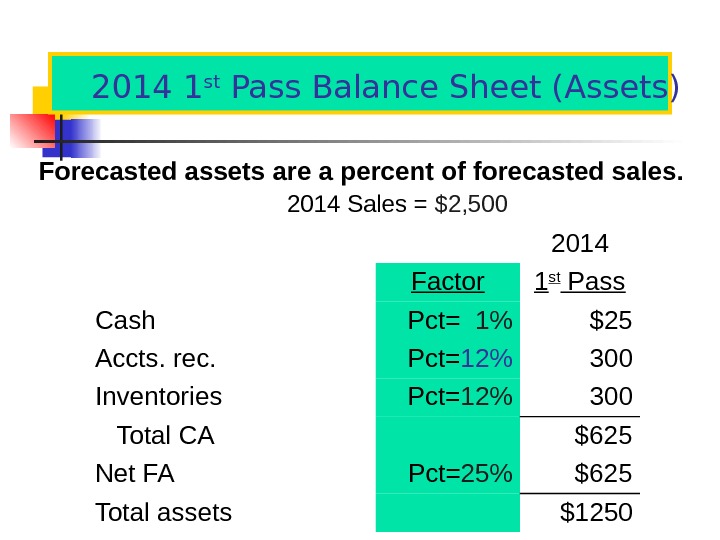
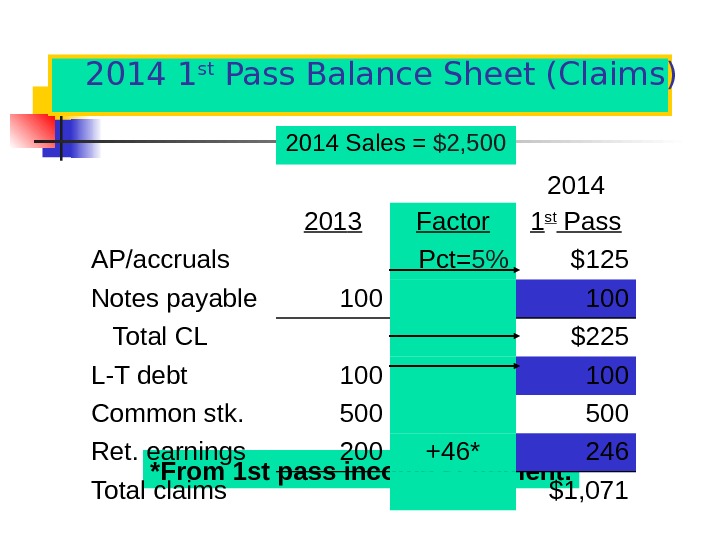
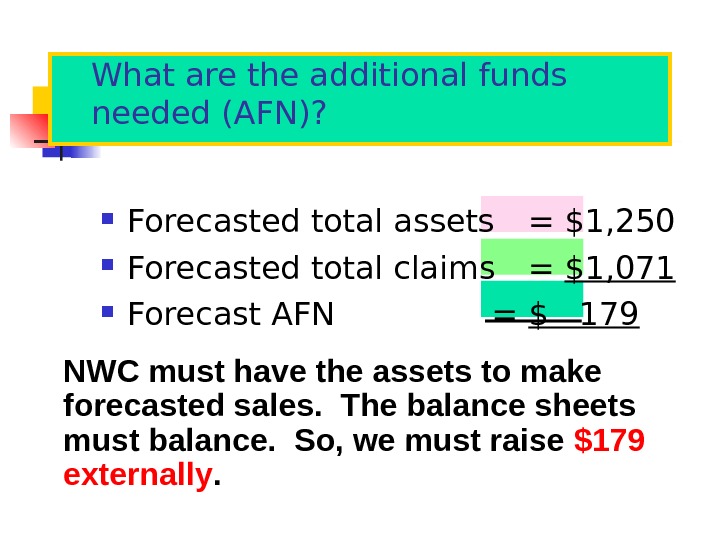
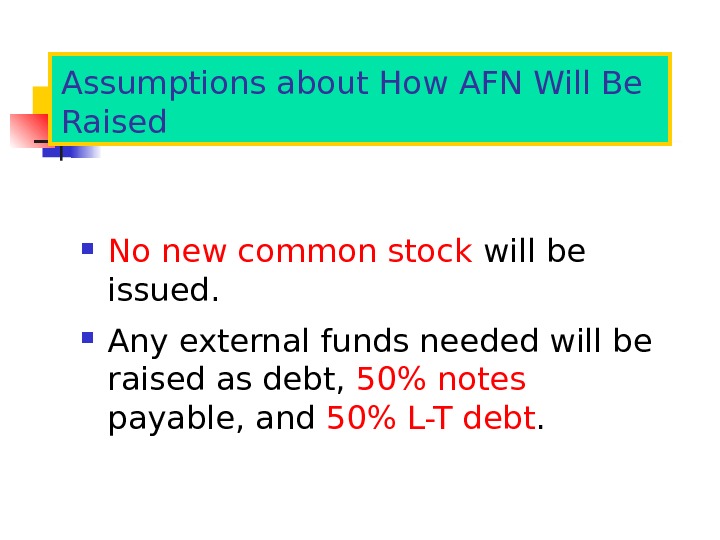
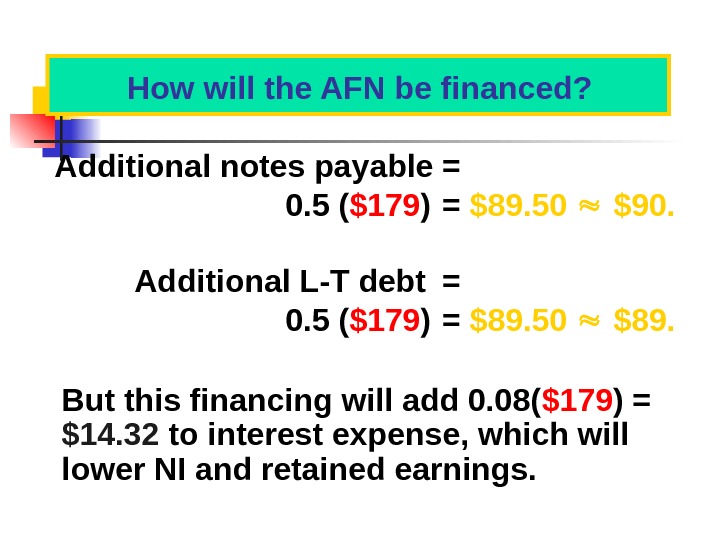

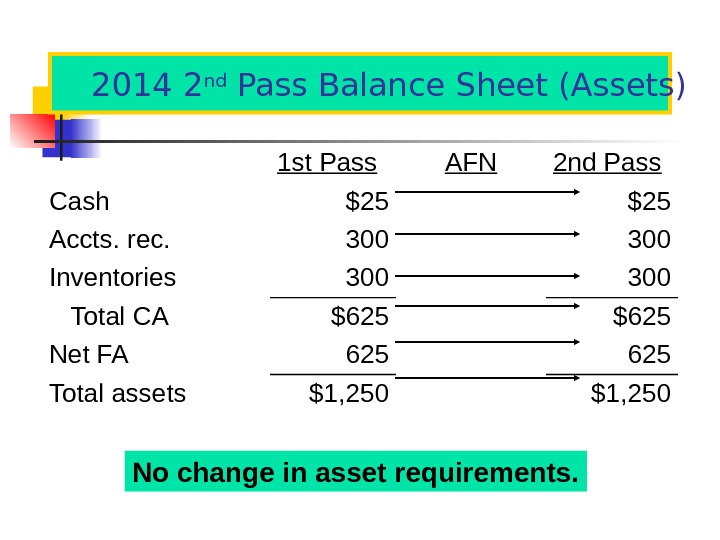
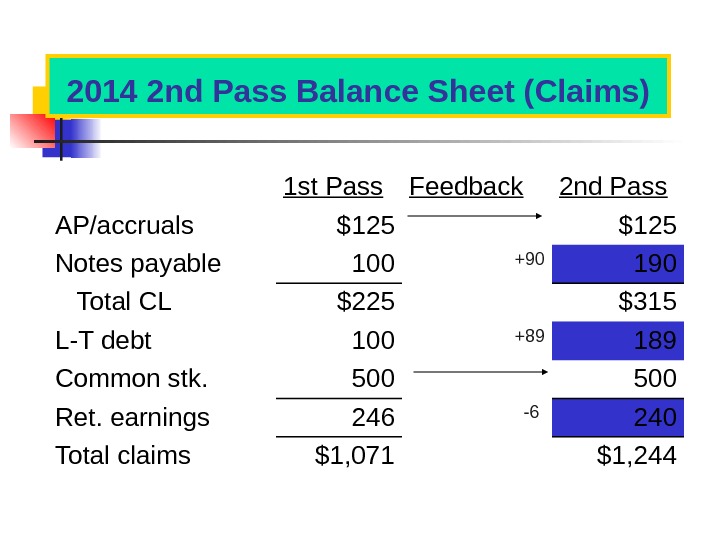
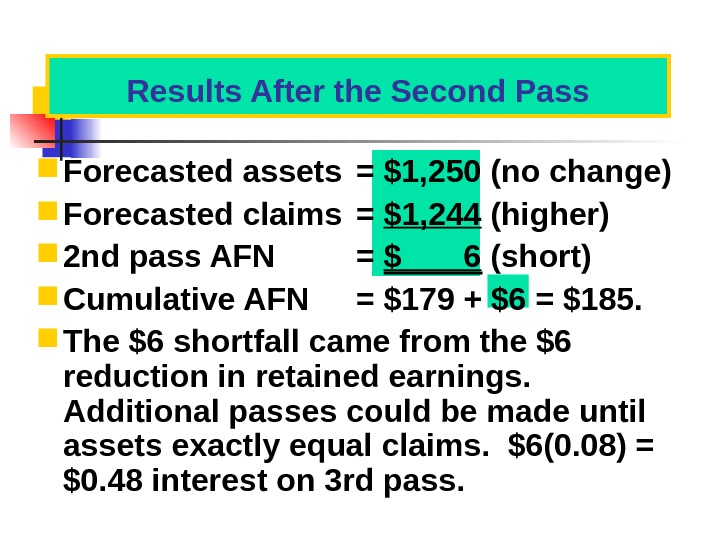
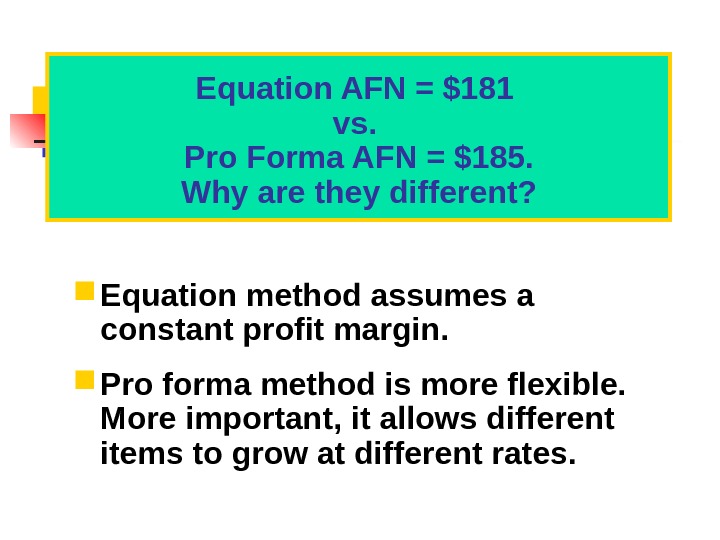
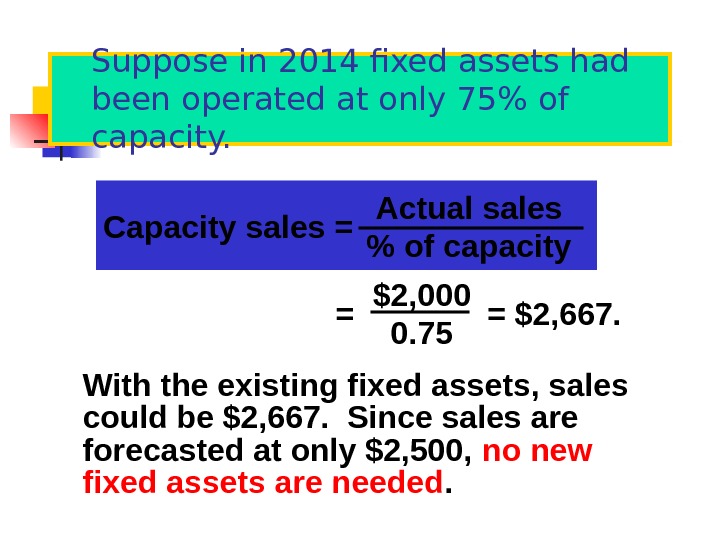
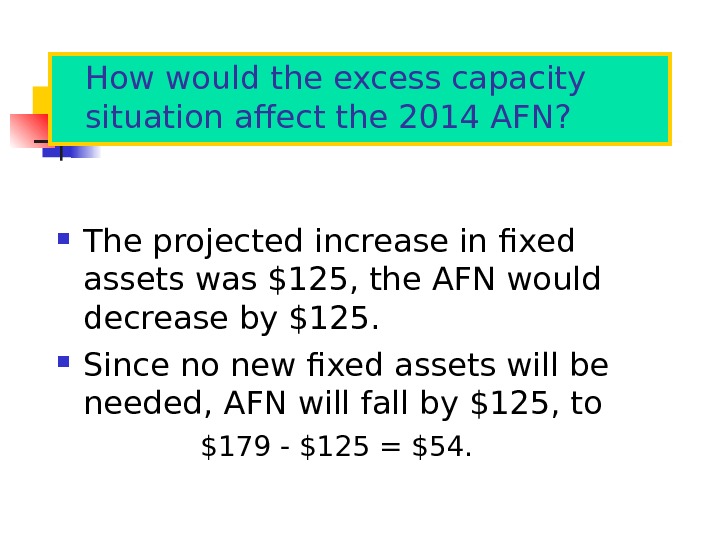
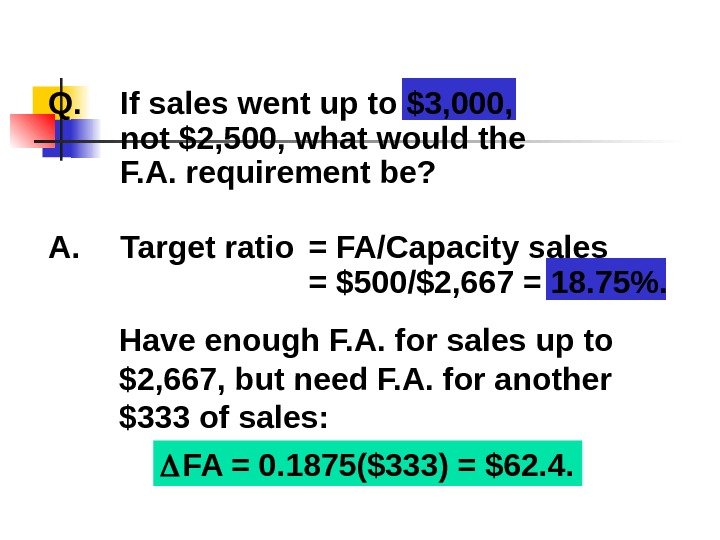
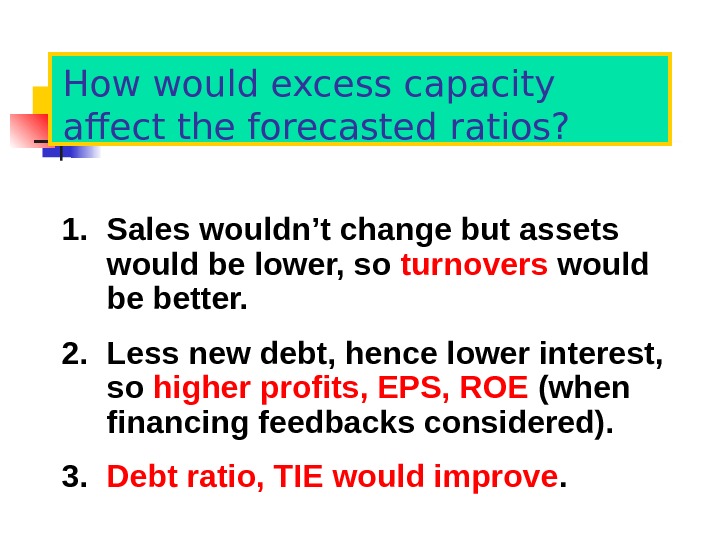
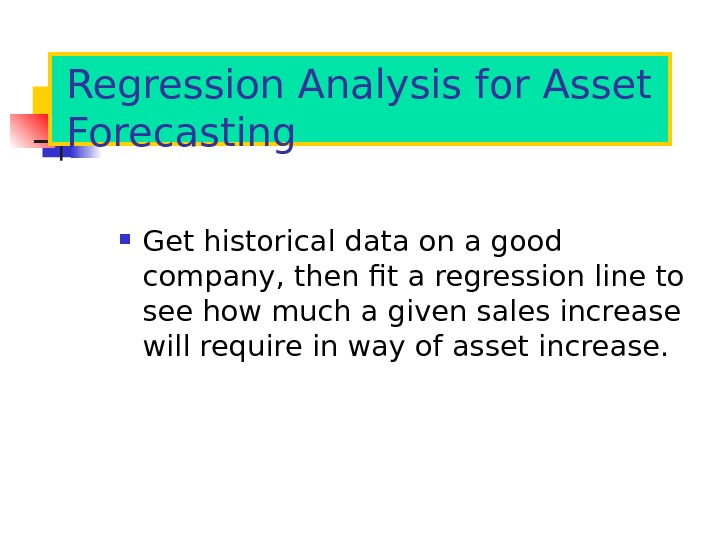
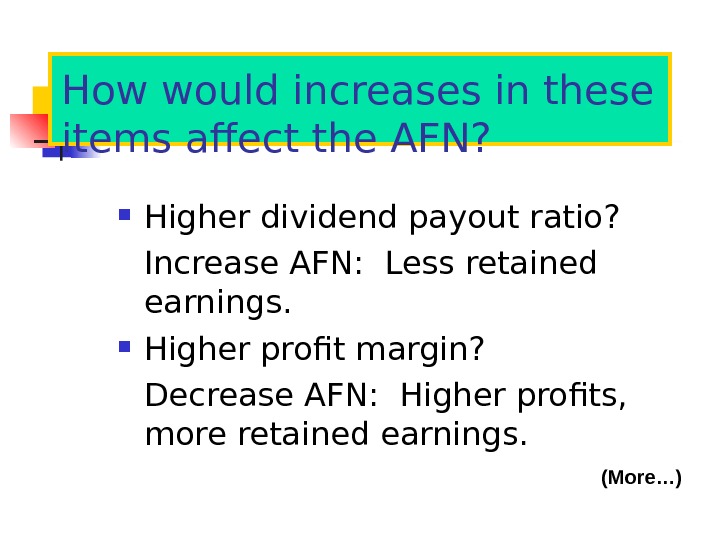
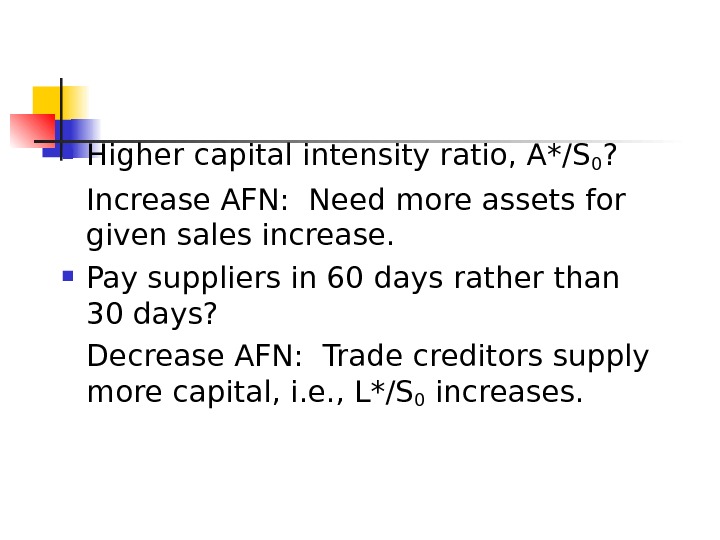
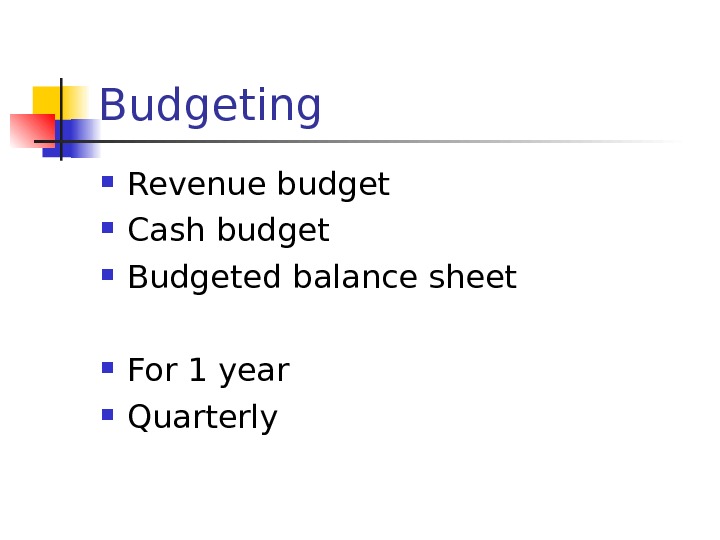
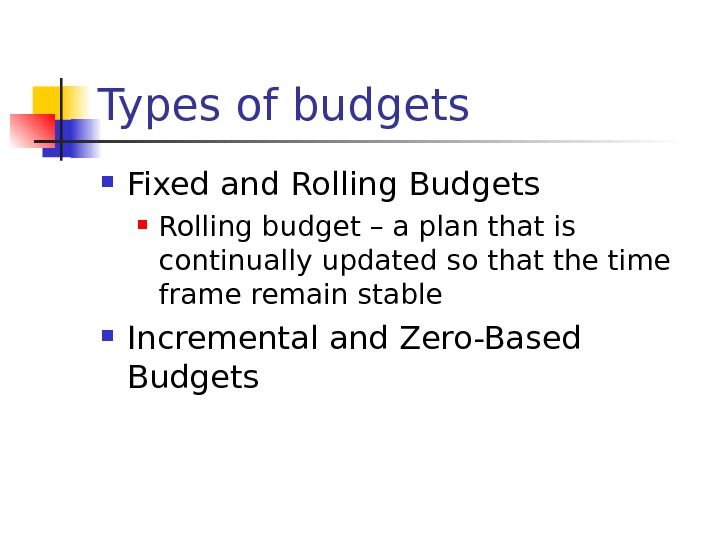
financial1.planning.and.forecasting.ppt
- Размер: 712 Кб
- Количество слайдов: 39
Описание презентации Financial Planning Plans: strategic, operating, по слайдам
 Financial Planning Plans: strategic, operating, and financial Pro forma financial statements Sales forecasts Percent of sales method Additional Funds Needed (AFN) formula
Financial Planning Plans: strategic, operating, and financial Pro forma financial statements Sales forecasts Percent of sales method Additional Funds Needed (AFN) formula
 Task of financial planning Cover a short time span Take a long term perspective Focus on required resources for a specific projects
Task of financial planning Cover a short time span Take a long term perspective Focus on required resources for a specific projects
 Financial plan Adaptable tool for management to use to achieve its strategic goals Translation of strategic plan into measurable quantities that express the expected resources and anticipated return over a certain period Presents the estimated future financial statements
Financial plan Adaptable tool for management to use to achieve its strategic goals Translation of strategic plan into measurable quantities that express the expected resources and anticipated return over a certain period Presents the estimated future financial statements
 Goals of financial planning Three important uses: Forecast the amount and sources of financing that will be required Evaluate the impact that changes in the operating plan have on the value of the firm Set appropriate targets for compensation plans
Goals of financial planning Three important uses: Forecast the amount and sources of financing that will be required Evaluate the impact that changes in the operating plan have on the value of the firm Set appropriate targets for compensation plans
 What answers should Financial planning give to the manager? What is the size of financial funds that company has? What are their sources? Do we have enough funds to reach our goals? What part of funds we should transact to the budget, state funds, to banks and to other lenders? How should we use our profit? Are our real revenues and planned expenses balanced?
What answers should Financial planning give to the manager? What is the size of financial funds that company has? What are their sources? Do we have enough funds to reach our goals? What part of funds we should transact to the budget, state funds, to banks and to other lenders? How should we use our profit? Are our real revenues and planned expenses balanced?
 Financial planning Long term – more than 3 years Medium-term – for 1 -3 years Short-term — budgeting
Financial planning Long term – more than 3 years Medium-term – for 1 -3 years Short-term — budgeting
 Financial Planning The projection of sales, income, and assets based on alternative production and marketing strategies, as well as the determination of the resources needed to achieve these projections. Forecasting also is important for production planning and human resource planning. Financial Planning
Financial Planning The projection of sales, income, and assets based on alternative production and marketing strategies, as well as the determination of the resources needed to achieve these projections. Forecasting also is important for production planning and human resource planning. Financial Planning
 Steps to get AFN – simple one-pass forecast balance sheet method 1. Calculate RE with the data given (method varies) 2. Increase CA and spontaneous liabilities proportionately with sales 3. Increase FA if needed based on capacity information given 4. Carry over bonds/bank-loans and stock 5. Calculate TA — (TL+E) = AFN = additional funds needed from external sources
Steps to get AFN – simple one-pass forecast balance sheet method 1. Calculate RE with the data given (method varies) 2. Increase CA and spontaneous liabilities proportionately with sales 3. Increase FA if needed based on capacity information given 4. Carry over bonds/bank-loans and stock 5. Calculate TA — (TL+E) = AFN = additional funds needed from external sources
 Steps in Financial Forecasting Forecast sales Project the assets needed to support sales Project internally generated funds Project outside funds needed Decide how to raise funds See effects of plan on ratios and stock price
Steps in Financial Forecasting Forecast sales Project the assets needed to support sales Project internally generated funds Project outside funds needed Decide how to raise funds See effects of plan on ratios and stock price
 2013 Balance Sheet (Millions of $) Cash & sec. $20 Accts. pay. & accruals $100 Accounts rec. 240 Notes payable 100 Inventories 240 Total CL $200 Total CA $500 L-T debt 100 Common stk 500 Net fixed Retained Assets 500 Earnings 200 Total assets $100 0 Total claims $
2013 Balance Sheet (Millions of $) Cash & sec. $20 Accts. pay. & accruals $100 Accounts rec. 240 Notes payable 100 Inventories 240 Total CL $200 Total CA $500 L-T debt 100 Common stk 500 Net fixed Retained Assets 500 Earnings 200 Total assets $100 0 Total claims $
 2013 Income Statement (Millions of $) Sales $2, 000. 0 0 Less: COGS (60%) 1, 200. 00 SGA costs 700. 00 EBIT $100. 00 Interest 16. 00 EBT $84. 00 Taxes (40%) 33. 60 Net income $50. 40 Dividends (30%) $15. 12 Add’n to RE 35.
2013 Income Statement (Millions of $) Sales $2, 000. 0 0 Less: COGS (60%) 1, 200. 00 SGA costs 700. 00 EBIT $100. 00 Interest 16. 00 EBT $84. 00 Taxes (40%) 33. 60 Net income $50. 40 Dividends (30%) $15. 12 Add’n to RE 35.
 AFN (Additional Funds Needed): Key Assumptions Operating at full capacity in 2013. Each type of asset grows proportionally with sales. Payables and accruals grow proportionally with sales. 2013 profit margin (2. 52%) and payout (30%) will be maintained. Sales are expected to increase by $500 million. (% S = 25%)
AFN (Additional Funds Needed): Key Assumptions Operating at full capacity in 2013. Each type of asset grows proportionally with sales. Payables and accruals grow proportionally with sales. 2013 profit margin (2. 52%) and payout (30%) will be maintained. Sales are expected to increase by $500 million. (% S = 25%)
 Assets Sales 01, 000 2, 0001, 250 2, 500 A*/S 0 = $1, 000/$2, 000 = 0. 5 = $1, 250/$2, 500. Assets = (A*/S 0 ) Sales = 0. 5($500) = $250. Assets = 0. 5 sales
Assets Sales 01, 000 2, 0001, 250 2, 500 A*/S 0 = $1, 000/$2, 000 = 0. 5 = $1, 250/$2, 500. Assets = (A*/S 0 ) Sales = 0. 5($500) = $250. Assets = 0. 5 sales
 Additional Funds Needed AFN = Asset requirement — Spontaneous financing — Retained earnings = (A*/S 0 ) Δ S — (L*/S 0 ) Δ S — M(S 1 )(1 — d) Where: A* = Assets tied directly to sales and will increase L* = Spontaneous liabilities that will be affected by sales. S 0 = Sales during the last year S 1 = Total sales projected for next year (the new level of sales). Δ S = The increase in sales between S 0 and S 1 M = Profit margin, or the profit per unit of sales d = payout ratio
Additional Funds Needed AFN = Asset requirement — Spontaneous financing — Retained earnings = (A*/S 0 ) Δ S — (L*/S 0 ) Δ S — M(S 1 )(1 — d) Where: A* = Assets tied directly to sales and will increase L* = Spontaneous liabilities that will be affected by sales. S 0 = Sales during the last year S 1 = Total sales projected for next year (the new level of sales). Δ S = The increase in sales between S 0 and S 1 M = Profit margin, or the profit per unit of sales d = payout ratio
 Assets must increase by $250 million. What is the AFN, based on the AFN equation? AFN = (A*/S 0 ) S — (L*/S 0 ) S — M(S 1 )(1 — d) = ($1, 000/$2, 000)($500) — ($100/$2, 000)($500) — 0. 0252($2, 500)(1 — 0. 3) = $180. 9 million.
Assets must increase by $250 million. What is the AFN, based on the AFN equation? AFN = (A*/S 0 ) S — (L*/S 0 ) S — M(S 1 )(1 — d) = ($1, 000/$2, 000)($500) — ($100/$2, 000)($500) — 0. 0252($2, 500)(1 — 0. 3) = $180. 9 million.
 Projecting Pro Forma Statements with the Percent of Sales Method Project sales based on forecasted growth rate in sales Forecast some items as a percent of the forecasted sales Costs Cash Accounts receivable (More. . . )
Projecting Pro Forma Statements with the Percent of Sales Method Project sales based on forecasted growth rate in sales Forecast some items as a percent of the forecasted sales Costs Cash Accounts receivable (More. . . )
 Items as percent of sales (Continued. . . ) Inventories Net fixed assets Accounts payable and accruals Choose other items Debt (which determines interest) Dividends (which determines retained earnings) Common stock
Items as percent of sales (Continued. . . ) Inventories Net fixed assets Accounts payable and accruals Choose other items Debt (which determines interest) Dividends (which determines retained earnings) Common stock
 Percent of Sales: Inputs 201 3 201 4 Actual Proj. COGS/Sales 60% SGA/Sales 35% Cash/Sales 1% 1% Acct. rec. /Sales 12% Inv. /Sales 12% Net FA/Sales 25% AP & accr. /Sales 5% 5%
Percent of Sales: Inputs 201 3 201 4 Actual Proj. COGS/Sales 60% SGA/Sales 35% Cash/Sales 1% 1% Acct. rec. /Sales 12% Inv. /Sales 12% Net FA/Sales 25% AP & accr. /Sales 5% 5%
 Other Inputs Percent growth in sales 25% Growth factor in sales (g) 1. 25 Interest rate on debt 8% Tax rate 40% Dividend payout rate 30%
Other Inputs Percent growth in sales 25% Growth factor in sales (g) 1. 25 Interest rate on debt 8% Tax rate 40% Dividend payout rate 30%
 2014 1 st Pass Income Statement 201 4 201 3 Factor 1 st Pass Sales $2, 000 g= 1. 25 $2, 500 Less: COGS Pct= 60% 1, 500 SGA Pct= 35% 875 EBIT $125 Interest 16 16 EBT $109 Taxes (40%) 44 Net. Income $65 Div. (30%) $19 Add. to RE $
2014 1 st Pass Income Statement 201 4 201 3 Factor 1 st Pass Sales $2, 000 g= 1. 25 $2, 500 Less: COGS Pct= 60% 1, 500 SGA Pct= 35% 875 EBIT $125 Interest 16 16 EBT $109 Taxes (40%) 44 Net. Income $65 Div. (30%) $19 Add. to RE $
 2014 1 st Pass Balance Sheet (Assets) Forecasted assets are a percent of forecasted sales. 201 4 Sales = $2, 500 20 14 Factor 1 st Pass Cash Pct= 1% $25 Accts. rec. Pct= 12% 300 Inventories Pct= 12% 300 Total CA $625 Net FA Pct= 25% $625 Total assets $
2014 1 st Pass Balance Sheet (Assets) Forecasted assets are a percent of forecasted sales. 201 4 Sales = $2, 500 20 14 Factor 1 st Pass Cash Pct= 1% $25 Accts. rec. Pct= 12% 300 Inventories Pct= 12% 300 Total CA $625 Net FA Pct= 25% $625 Total assets $
 2014 1 st Pass Balance Sheet (Claims) *From 1 st pass income statement. 201 4 Sales = $2, 500 201 4 201 3 Factor 1 st Pass AP/accruals Pct= 5% $125 Notes payable 100 Total CL $225 L-T debt 100 Common stk. 500 Ret. earnings 200 +46* 246 Total claims $1,
2014 1 st Pass Balance Sheet (Claims) *From 1 st pass income statement. 201 4 Sales = $2, 500 201 4 201 3 Factor 1 st Pass AP/accruals Pct= 5% $125 Notes payable 100 Total CL $225 L-T debt 100 Common stk. 500 Ret. earnings 200 +46* 246 Total claims $1,
 What are the additional funds needed (AFN)? Forecasted total assets = $1, 250 Forecasted total claims = $1, 071 Forecast AFN = $ 179 NWC must have the assets to make forecasted sales. The balance sheets must balance. So, we must raise $179 externally.
What are the additional funds needed (AFN)? Forecasted total assets = $1, 250 Forecasted total claims = $1, 071 Forecast AFN = $ 179 NWC must have the assets to make forecasted sales. The balance sheets must balance. So, we must raise $179 externally.
 Assumptions about How AFN Will Be Raised No new common stock will be issued. Any external funds needed will be raised as debt, 50% notes payable, and 50% L-T debt.
Assumptions about How AFN Will Be Raised No new common stock will be issued. Any external funds needed will be raised as debt, 50% notes payable, and 50% L-T debt.
 How will the AFN be financed? Additional notes payable = 0. 5 ( $179 ) = $89. 50 $90. Additional L-T debt = 0. 5 ( $179 ) = $89. 50 $89. But this financing will add 0. 08( $179 ) = $14. 32 to interest expense, which will lower NI and retained earnings.
How will the AFN be financed? Additional notes payable = 0. 5 ( $179 ) = $89. 50 $90. Additional L-T debt = 0. 5 ( $179 ) = $89. 50 $89. But this financing will add 0. 08( $179 ) = $14. 32 to interest expense, which will lower NI and retained earnings.
 1 st Pass Feedback 2 nd Pass Sales $2, 500 Less: COGS $1, 500 SGA 875 EBIT $125 Interest 16 +14 30 EBT $109 $95 Taxes (40%) 44 38 Net income $65 $57 Div (30%) $19 $17 Add. to RE $46 $402014 2 nd Pass Income Statement
1 st Pass Feedback 2 nd Pass Sales $2, 500 Less: COGS $1, 500 SGA 875 EBIT $125 Interest 16 +14 30 EBT $109 $95 Taxes (40%) 44 38 Net income $65 $57 Div (30%) $19 $17 Add. to RE $46 $402014 2 nd Pass Income Statement
 2014 2 nd Pass Balance Sheet (Assets) No change in asset requirements. 1 st Pass AFN 2 nd Pass Cash $25 Accts. rec. 300 Inventories 300 Total CA $625 Net FA 625 Total assets $1,
2014 2 nd Pass Balance Sheet (Assets) No change in asset requirements. 1 st Pass AFN 2 nd Pass Cash $25 Accts. rec. 300 Inventories 300 Total CA $625 Net FA 625 Total assets $1,
 2014 2 nd Pass Balance Sheet (Claims) 1 st Pass Feedback 2 nd Pass AP/accruals $125 Notes payable 100 +90 190 Total CL $225 $315 L-T debt 100 +89 189 Common stk. 500 Ret. earnings 246 -6 240 Total claims $1, 071 $1,
2014 2 nd Pass Balance Sheet (Claims) 1 st Pass Feedback 2 nd Pass AP/accruals $125 Notes payable 100 +90 190 Total CL $225 $315 L-T debt 100 +89 189 Common stk. 500 Ret. earnings 246 -6 240 Total claims $1, 071 $1,
 Forecasted assets = $1, 250 (no change) Forecasted claims = $1, 244 (higher) 2 nd pass AFN = $ 6 (short) Cumulative AFN = $179 + $6 = $185. The $6 shortfall came from the $6 reduction in retained earnings. Additional passes could be made until assets exactly equal claims. $6(0. 08) = $0. 48 interest on 3 rd pass. Results After the Second Pass
Forecasted assets = $1, 250 (no change) Forecasted claims = $1, 244 (higher) 2 nd pass AFN = $ 6 (short) Cumulative AFN = $179 + $6 = $185. The $6 shortfall came from the $6 reduction in retained earnings. Additional passes could be made until assets exactly equal claims. $6(0. 08) = $0. 48 interest on 3 rd pass. Results After the Second Pass
 Equation method assumes a constant profit margin. Pro forma method is more flexible. More important, it allows different items to grow at different rates. Equation AFN = $181 vs. Pro Forma AFN = $185. Why are they different?
Equation method assumes a constant profit margin. Pro forma method is more flexible. More important, it allows different items to grow at different rates. Equation AFN = $181 vs. Pro Forma AFN = $185. Why are they different?
 Suppose in 2014 fixed assets had been operated at only 75% of capacity. With the existing fixed assets, sales could be $2, 667. Since sales are forecasted at only $2, 500, no new fixed assets are needed. Capacity sales = Actual sales % of capacity = = $2, 667. $2, 000 0.
Suppose in 2014 fixed assets had been operated at only 75% of capacity. With the existing fixed assets, sales could be $2, 667. Since sales are forecasted at only $2, 500, no new fixed assets are needed. Capacity sales = Actual sales % of capacity = = $2, 667. $2, 000 0.
 How would the excess capacity situation affect the 2014 AFN? The projected increase in fixed assets was $125, the AFN would decrease by $125. Since no new fixed assets will be needed, AFN will fall by $125, to $179 — $125 = $54.
How would the excess capacity situation affect the 2014 AFN? The projected increase in fixed assets was $125, the AFN would decrease by $125. Since no new fixed assets will be needed, AFN will fall by $125, to $179 — $125 = $54.
 Q. If sales went up to $3, 000, not $2, 500, what would the F. A. requirement be? A. Target ratio = FA/Capacity sales = $500/$2, 667 = 18. 75%. Have enough F. A. for sales up to $2, 667, but need F. A. for another $333 of sales: FA = 0. 1875($333) = $62. 4.
Q. If sales went up to $3, 000, not $2, 500, what would the F. A. requirement be? A. Target ratio = FA/Capacity sales = $500/$2, 667 = 18. 75%. Have enough F. A. for sales up to $2, 667, but need F. A. for another $333 of sales: FA = 0. 1875($333) = $62. 4.
 How would excess capacity affect the forecasted ratios? 1. Sales wouldn’t change but assets would be lower, so turnovers would be better. 2. Less new debt, hence lower interest, so higher profits, EPS, ROE (when financing feedbacks considered). 3. Debt ratio, TIE would improve.
How would excess capacity affect the forecasted ratios? 1. Sales wouldn’t change but assets would be lower, so turnovers would be better. 2. Less new debt, hence lower interest, so higher profits, EPS, ROE (when financing feedbacks considered). 3. Debt ratio, TIE would improve.
 Regression Analysis for Asset Forecasting Get historical data on a good company, then fit a regression line to see how much a given sales increase will require in way of asset increase.
Regression Analysis for Asset Forecasting Get historical data on a good company, then fit a regression line to see how much a given sales increase will require in way of asset increase.
 How would increases in these items affect the AFN? Higher dividend payout ratio? Increase AFN: Less retained earnings. Higher profit margin? Decrease AFN: Higher profits, more retained earnings. (More…)
How would increases in these items affect the AFN? Higher dividend payout ratio? Increase AFN: Less retained earnings. Higher profit margin? Decrease AFN: Higher profits, more retained earnings. (More…)
 Higher capital intensity ratio, A*/S 0 ? Increase AFN: Need more assets for given sales increase. Pay suppliers in 60 days rather than 30 days? Decrease AFN: Trade creditors supply more capital, i. e. , L*/S 0 increases.
Higher capital intensity ratio, A*/S 0 ? Increase AFN: Need more assets for given sales increase. Pay suppliers in 60 days rather than 30 days? Decrease AFN: Trade creditors supply more capital, i. e. , L*/S 0 increases.
 Budgeting Revenue budget Cash budget Budgeted balance sheet For 1 year Quarterly
Budgeting Revenue budget Cash budget Budgeted balance sheet For 1 year Quarterly
 Types of budgets Fixed and Rolling Budgets Rolling budget – a plan that is continually updated so that the time frame remain stable Incremental and Zero-Based Budgets
Types of budgets Fixed and Rolling Budgets Rolling budget – a plan that is continually updated so that the time frame remain stable Incremental and Zero-Based Budgets

